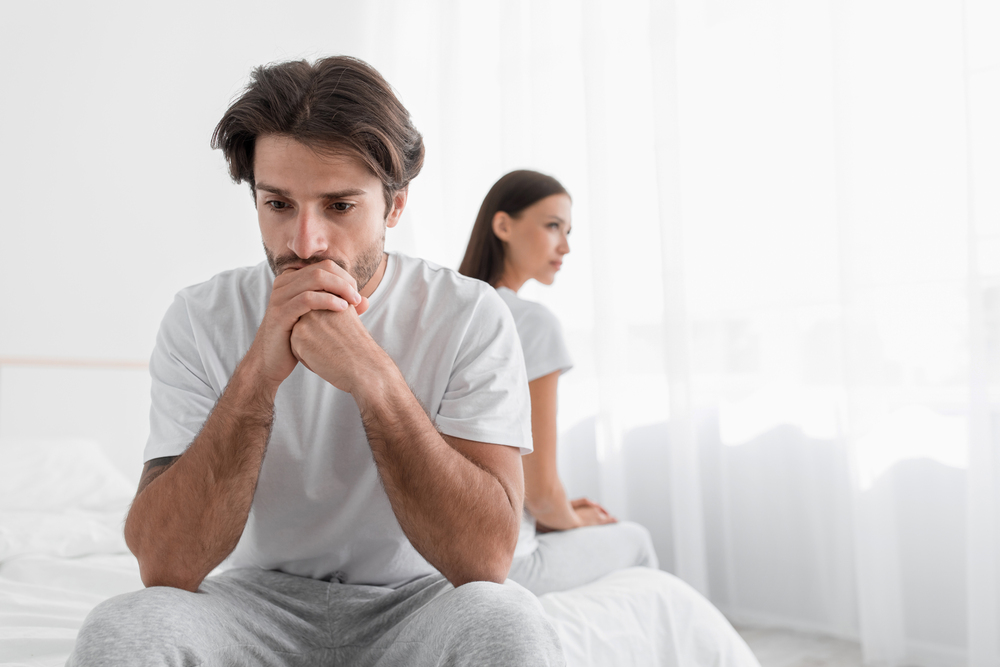What Causes Erectile Dysfunction?

Content by

Last Updated
Start a Consultation Today
Science means that ED can be optional.
No fancy packaging. No unwanted subscriptions. Delivered discreetly.
Erectile dysfunction, also known as impotence, is a common type of penile disorder in men. It can significantly harm a person’s confidence and quality of life. Many people believe that age is the main cause. However, ageing does not directly cause it, although it is a risk factor.
There are other reasons why erectile dysfunction occurs. Understanding the causes is crucial for both those who are affected by it and their partners. Finding the root cause allows those affected to treat it properly and can also help to prevent it from happening in the future.
In this article, we discuss the different causes of erectile dysfunction including physical and physiological issues. We also cover how it is treated and answer the age old question - can cycling cause erectile dysfunction?
Table of Contents
- What is Erectile Dysfunction?
- Physical Causes
- Psychological Causes
- Can Cycling Cause Erectile Dysfunction?
- How to Treat Erectile Dysfunction?
What is Erectile Dysfunction?
Erectile dysfunction (ED), also known as impotence, is defined as the inability to achieve or maintain an erection suitable for sufficient sexual activity. It is estimated that around 4.3 million men (1 in 5 men) across the UK experience erectile dysfunction. [1] The condition is more common in men over 40 years old.
Having problems with erections from time to time is not necessarily ED. However, it can be a temporary or a chronic problem. Many men experience it frequently and have ongoing issues, leading to decreased intimacy with partners and a lack of self-esteem.
The process of an erection involves many parts of the body including the brain, hormones, emotions, nerves, blood vessels and penile muscles. Upon sexual arousal or stimulation, the brain releases neurotransmitters that relax and widen the blood vessels in the penis. This allows for increased blood flow into the erectile tissue and causes the penis to be erect.
Erectile dysfunction occurs when the penile muscles contract, stopping the inflow of blood and opening outflow channels. As the blood flow decreases in the penis, the effect is reversed and the penis returns to a flaccid state.
Physical Causes
There are a variety of physical causes that can contribute to erectile dysfunction. These include:
- Hormone Levels - If a man experiences a hormonal imbalance, especially low testosterone levels, this can impact their ability to achieve and maintain an erection. An overactive or underactive thyroid can also contribute to erectile dysfunction.
- Cardiovascular Issues - Poor blood flow to the penis can cause erectile dysfunction. Cardiovascular diseases such as high blood pressure, high cholesterol, atherosclerosis and heart disease can lead to restricted blood flow, which can in turn affect the ability to achieve and maintain an erection.
- Nerve Damage - Damage to the nerves can result in erectile dysfunction. Conditions including multiple sclerosis (MS) and spinal cord injuries, can interfere with the transmission of signals between the brain and the penis.
- Peyronie’s Disease - This condition involves the development of scar tissue within the penis, causing it to bend or curve. It can also cause painful erections and erectile dysfunction.
- Diabetes - Men with diabetes are three times more likely to experience some form of erectile dysfunction. Diabetes can cause damage to the nerves and blood vessels, making it more difficult to get or keep an erection. [2]
- Tobacco and Alcohol Use - Both smoking and excessive alcohol consumption can damage blood vessels and interfere with blood flow, leading to erectile dysfunction.
- Other Medications - Erectile dysfunction can be a side effect of certain medications such as antidepressants, antihistamines, blood pressure medication and prostate cancer drugs.
Psychological Causes
The brain plays a crucial role in triggering the events which cause an erection. In addition to physical factors, psychological issues can also play a role in erectile dysfunction. Some of the psychological causes of this condition include:
- Stress and Anxiety - High levels of stress and anxiety can interfere with sexual arousal and performance, leading to erectile dysfunction.
- Depression - Those who suffer from depression can experience reduced libido and find it difficult to become sexually aroused, leading to erection problems.
- Relationship Problems - Conflict or tension within a relationship can cause erectile dysfunction by interfering with emotions and sexual feelings.
- Performance Anxiety - The desire to pleasure a sexual partner can cause men to worry about their performance and lead to difficulty with achieving or maintaining an erection.
Can Cycling Cause Erectile Dysfunction?
While cycling is a low-impact and enjoyable activity, it may cause temporary erectile dysfunction. In recent years, there has been research that links cycling and erectile dysfunction.
One study found that a bike seat can put pressure on the perineum (the area between the genitals and anus). Constant pressure on this area can damage the nerves and compress arteries in the penis. This compression reduces the amount of blood flow to the penis, resulting in tingling or numbness in the area which may lead to erectile problems. It also claims that the risk of developing erectile dysfunction was higher amongst those who cycled for more than 3 hours a week. [3]
If you’re concerned, there are a few ways of reducing the risk of developing erectile dysfunction while still being able to enjoy a long bike ride:
- Change the bike seat - switch out the standard narrow bike seat for a wider one for better support. Alternatively, choose a seat without a nose to reduce pressure on the perineum.
- Change the handlebar height - Lowering the handlebars allows you to lean forward while cycling, minimising pressure on the perineum. The handlebars should be lower than the seat height.
- Wear padded shorts - Padded cycling shorts can support the perineum, giving an extra level of comfort and protection.
- Take regular breaks - if you are cycling for long periods of time, make sure to take regular breaks to ease pressure on the perineum.
How to Treat Erectile Dysfunction?
Unfortunately, there is no cure for erectile dysfunction, but it can be treated. Oral medications are usually the first-line of treatment.
At Chemist Click, we offer a wide range of erectile dysfunction treatments through a free and confidential online consultation. Medications such as Sildenafil and Viagra are types of PDE5 inhibitors which block the PDE5 enzyme and improve blood flow to the penis, causing a firm and long-lasting erection. One tablet is to be taken once a day between 30 minutes and 1 hour before engaging in sexual activity and the effects can last for an average of 4 hours.
Before taking any treatment for erectile dysfunction, please read the product information leaflet or consult with your GP. It is important to seek medical advice and treatment if you're experiencing symptoms of erectile dysfunction, as if left untreated, it can have a significant impact on your quality of life and relationships.
Sources
- The Urology Foundation (2024). What is Erectile Dysfunction (ED). Retrieved 24th September 2024, from: https://www.theurologyfoundation.org/urology-health/male-reproductive-organs-conditions/erectile-dysfunction/
- Diabetes UK. (n.d). Diabetes and sexual problems – in men. Retrieved 24th September 2024, from: https://www.diabetes.org.uk/guide-to-diabetes/complications/sexual-problems-men
- Harvard Health Publishing. (2021). Can cycling cause erectile dysfunction? Retrieved 24th September 2024, from: https://www.health.harvard.edu/staying-healthy/can-cycling-cause-erectile-dysfunction
Whilst all of our content is written and reviewed by healthcare professionals, it is not intended to be substituted for or used as medical advice. If you have any questions or concerns about your health, please speak to your doctor.
